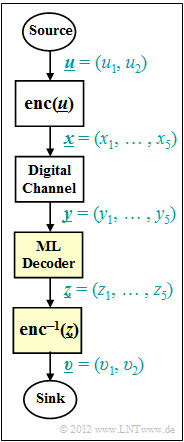Exercise 1.4: Maximum Likelihood Decision
From LNTwww
We consider the digital transmission system according to the graph. Considered are:
- a systematic (5,2) block code C with the code words
- x_0 = (0,0,0,0,0), x_1 = (0,1,0,1,0), x_2 = (1,0,1,0,1), x_3 = (1,1,1,1,1);
- a digital (binary) channel model that changes the vector x_∈GF(25) over into the vector y_∈GF(25),
- a Maximum likelihood decoder (short: ML decoder) with the decision rule
- z_=argmax
Here, d_{\rm H} (\underline{y}, \ \underline{x_{i}}) is the Hamming distance between the received word \underline{y} and the (possibly) sent code word \underline{x_{i}}.
Note: This exercise belongs to the chapter "Channel Models and Decision Structures".
Questions
Solution
(1) Correct answer 3 ⇒ \underline{z} = \underline{x}_{2} = (1, 0, 1, 0, 1):
- The Hamming distances between the specific received word \underline{y} = (1, 0, 0, 0, 1) and the four possible code words \underline{x}_{i} are as follows:
- d_{\rm H}(\underline{y}, \hspace{0.05cm}\underline{x}_0) = 2\hspace{0.05cm}, \hspace{0.3cm} d_{\rm H}(\underline{y}, \hspace{0.05cm}\underline{x}_1) = 4\hspace{0.05cm}, \hspace{0.3cm} d_{\rm H}(\underline{y}, \hspace{0.05cm}\underline{x}_2) = 1\hspace{0.05cm}, \hspace{0.3cm} d_{\rm H}(\underline{y}, \hspace{0.05cm}\underline{x}_3) = 3\hspace{0.05cm}.
- A decision is made for the sequence with the smallest Hamming distance d_{\rm H}(\underline{y}, \hspace{0.05cm}\underline{x}_2) = 1.
(2) For \underline{y} = (0, 0, 0, 1, 0) the answers 1 and 2 are correct, as the following calculation shows:
- d_{\rm H}(\underline{y}, \hspace{0.05cm}\underline{x}_0) = 1\hspace{0.05cm}, \hspace{0.3cm} d_{\rm H}(\underline{y}, \hspace{0.05cm}\underline{x}_1) = 1\hspace{0.05cm}, \hspace{0.3cm} d_{\rm H}(\underline{y}, \hspace{0.05cm}\underline{x}_2) = 4\hspace{0.05cm}, \hspace{0.3cm} d_{\rm H}(\underline{y}, \hspace{0.05cm}\underline{x}_3) = 4\hspace{0.05cm}.
(3) Correct answer 3 ⇒ \underline{z} = \underline{x}_{2} = (1, 0, 1, 0, 1):
- According to the Hamming distance, a decision in favor of x_{2} would be just as possible as for x_{3} if the vector \underline{y} = (1, 0, 1, 1, 1) is received:
- d_{\rm H}(\underline{y}, \hspace{0.05cm}\underline{x}_0) = 4\hspace{0.05cm}, \hspace{0.3cm} d_{\rm H}(\underline{y}, \hspace{0.05cm}\underline{x}_1) = 4\hspace{0.05cm}, \hspace{0.3cm} d_{\rm H}(\underline{y}, \hspace{0.05cm}\underline{x}_2) = 1\hspace{0.05cm}, \hspace{0.3cm} d_{\rm H}(\underline{y}, \hspace{0.05cm}\underline{x}_3) = 1\hspace{0.05cm}.
- But the received vector \underline{y} is different from x_{2} with respect to the fourth bit and from x_{3} in the second bit.
- Since the fourth bit is more uncertain than the second, it will choose x_{2} .
(4) Since this is a systematic code, the decision for \underline{z} = (1, 0, 1, 0, 1) is equivalent to the decision
- v_{1} \ \underline{ = 1}, \ v_{2} \ \underline{= 0}.
- It is not certain that \underline{u} = (1, 0) was actually sent.
- But the probability is highest for this given the received vector \underline{y} = (1, 0, 1, 1, 1).
